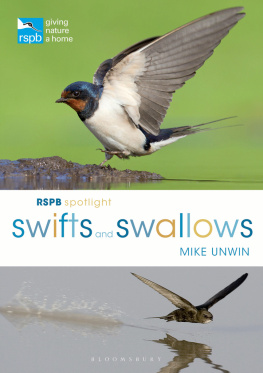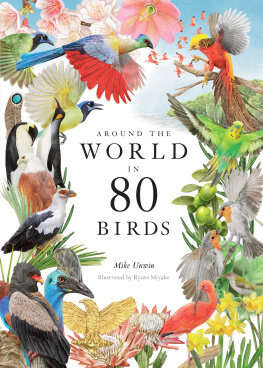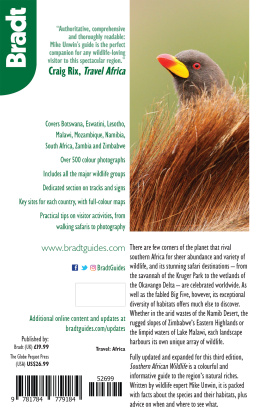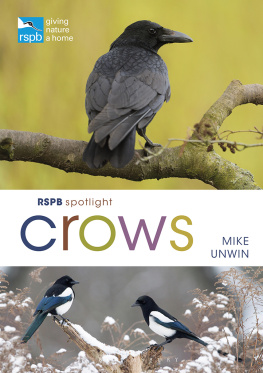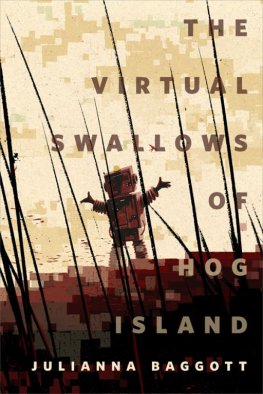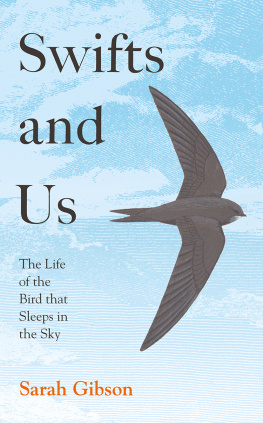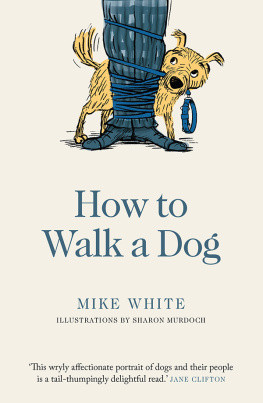Mike Unwin - Swifts and swallows
Here you can read online Mike Unwin - Swifts and swallows full text of the book (entire story) in english for free. Download pdf and epub, get meaning, cover and reviews about this ebook. year: 2018, genre: Home and family. Description of the work, (preface) as well as reviews are available. Best literature library LitArk.com created for fans of good reading and offers a wide selection of genres:
Romance novel
Science fiction
Adventure
Detective
Science
History
Home and family
Prose
Art
Politics
Computer
Non-fiction
Religion
Business
Children
Humor
Choose a favorite category and find really read worthwhile books. Enjoy immersion in the world of imagination, feel the emotions of the characters or learn something new for yourself, make an fascinating discovery.
- Book:Swifts and swallows
- Author:
- Genre:
- Year:2018
- Rating:5 / 5
- Favourites:Add to favourites
- Your mark:
- 100
- 1
- 2
- 3
- 4
- 5
Swifts and swallows: summary, description and annotation
We offer to read an annotation, description, summary or preface (depends on what the author of the book "Swifts and swallows" wrote himself). If you haven't found the necessary information about the book — write in the comments, we will try to find it.
Swifts and swallows — read online for free the complete book (whole text) full work
Below is the text of the book, divided by pages. System saving the place of the last page read, allows you to conveniently read the book "Swifts and swallows" online for free, without having to search again every time where you left off. Put a bookmark, and you can go to the page where you finished reading at any time.
Font size:
Interval:
Bookmark:


BLOOMSBURY WILDLIFE
Bloomsbury Publishing Plc
50 Bedford Square, London, WC1B 3DP, UK
This electronic edition published in 2018 by Bloomsbury Publishing Plc
BLOOMSBURY, BLOOMSBURY WILDLIFE and the Diana logo are trademarks of
Bloomsbury Publishing Plc
First published in Great Britain 2018
Copyright Mike Unwin, 2018
Mike Unwin has asserted his right under the Copyright, Designs and Patents Act, 1988, to be identified as Author of this work
For legal purposes the constitute an extension of this copyright page
All rights reserved
You may not copy, distribute, transmit, reproduce or otherwise make available this publication (or any part of it) in any form, or by any means (including without limitation electronic, digital, optical, mechanical, photocopying, printing, recording or otherwise), without the prior written permission of the publisher. Any person who does any unauthorised act in relation to this publication may be liable to criminal prosecution and civil claims for damages.
Bloomsbury Publishing Plc does not have any control over, or responsibility for, any third-party websites referred to or in this book. All internet addresses given in this book were correct at the time of going to press. The author and publisher regret any inconvenience caused if addresses have changed or sites have ceased to exist, but can accept no responsibility for any such changes
A catalogue record for this book is available from the British Library
Library of Congress Cataloguing-in-Publication data has been applied for
ISBN: 978-1-4729-5011-6 (PB)
ISBN: 978-1-4729-5009-3 (eBook)
ISBN: 978-1-4729-5010-9 (ePDF)
To find out more about our authors and their books please visit www.bloomsbury.com where you will find extracts, author interviews and details of forthcoming events, and to be the first to hear about latest releases and special offers, sign up for our newsletter.
For all items sold, Bloomsbury Publishing will donate a minimum of 2% of the publishers receipts from sales of licensed titles to RSPB Sales Ltd, the trading subsidiary of the RSPB. Subsequent sellers of this book are not commercial participators for the purpose of Part II of the Charities Act 1992.
Contents


When a Swift is perched, its exceptionally long wings project well beyond the end of its tail.
Meet the Swift and the Swallow
Darting and gliding through the summer skies, few birds are more impressive in the air than the Swift and the Swallow. The two have much in common: both feed on flying insects and have bodies similarly adapted for this challenge; both breed on or around buildings, bringing them into close contact with people; and both are long-distance migrants, arriving in the UK every spring after spending winter in sub-Saharan Africa. Given these similarities, and the superficial resemblance of the two birds, it is hardly surprising that they have long been closely associated. Indeed, many people often mistake one for the other.
Appearances, however, can be deceptive. Swifts and swallows are not related. Swallows belong to the order Passeriformes also known as passerines, or perching birds. This is the worlds largest order of birds and comprises at least 110 families, including the likes of thrushes, finches and warblers. Within this order, the swallows make up the family Hirundinidae, known as hirundines, of which our UK Swallow properly known as the Barn Swallow is one of some 83 species.
Swifts, however apparently similar to swallows, belong to the Apodiformes, a completely different and much smaller order that comprises just three families. Our UK Swift is one of some 100 species in the family Apodidae. Its two sister families in this small order are the tree swifts (Hemiprocnidae) and, believe it or not, the hummingbirds (Trochilidae). Swifts are thus much more closely related to hummingbirds than they are to swallows, and swallows are more closely related to magpies and robins than they are to swifts.

Unlike Swifts, Swallows habitually settle on fences, posts and other low perches.
These affinities may seem counter-intuitive. But the striking similarities between swifts and swallows are due to a phenomenon known as convergent evolution, in which animals from unconnected evolutionary roots evolve to resemble one another by adapting in similar ways to a shared environmental challenge. In this case, the challenge is catching flying insects on the wing, one that demands a special skill set and a body customised to the job.

Seen from side-on, a Swift reveals the aerodynamic lines of its body.
Growing together; moving apart
Unrelated species can evolve similar outward traits by adapting in similar ways to shared environmental challenges. This is called convergent evolution. The species in question have converged from different backgrounds towards a similar point, which is usually reflected in their build or behaviour. Swifts and swallows, for instance, both have long, narrow wings, forked tails, tiny feet, small bills, wide mouths and agile flight as adaptations for catching insects on the wing. Hummingbirds, on the other hand, which are related to swifts, have adapted to a very different lifestyle one of hovering in front of flowers in order to extract their nectar and so are quite different in appearance. This is an example of divergent evolution.

Both the Swift (left) and Swallow (right) share a similar aerodynamic profile, with long wings and a short head.
Meet the Swift

A close view of a Swift reveals the protective feathering that helps shield the eyes during high-speed flight.
The Swift the one member of the Apodidae found in the UK is properly known as the Common or Eurasian Swift, to distinguish it from other swift species around the world. For the purposes of this book, however, it is generally referred to as simply Swift, since this is the term most commonly used in the UK. Its scientific name Apus apus derives from the Greek word , meaning without feet. This refers to the ancient belief that swifts, whose tiny legs are barely visible to the casual observer, are simply legless swallows. The Common Swift was the first swift species to be scientifically described and has thus given its name to the Apodiformes order, embracing all swifts worldwide. We can only presume that the great Swedish naturalist Carl Linnaeus, who first described these birds in the tenth edition of his groundbreaking
Font size:
Interval:
Bookmark:
Similar books «Swifts and swallows»
Look at similar books to Swifts and swallows. We have selected literature similar in name and meaning in the hope of providing readers with more options to find new, interesting, not yet read works.
Discussion, reviews of the book Swifts and swallows and just readers' own opinions. Leave your comments, write what you think about the work, its meaning or the main characters. Specify what exactly you liked and what you didn't like, and why you think so.

